5G Mobile Communication: Technologies, Trends, and Analysis
VerifiedAdded on 2022/08/22
|12
|2848
|18
Report
AI Summary
This report provides a comprehensive analysis of 5G mobile communication, exploring its key technologies, development trends, and potential applications. It begins with an introduction defining 5G and its advancements over 4G, emphasizing improvements in user experience, system security, and flexibility. The literature review examines various use cases like enhanced Mobile Broadband (eMBB), massive Machine-Type Communication (mMTC), and Ultra Reliable Low-Latency Communications (UR-LLC). Key enablers such as Network Function Virtualization (NFV), Software Defined Networking (SDN), Cloud RAN, and Massive MIMO are discussed. The report then analyzes the impact of 5G on virtual reality, user experience, smart cities, HD video, and the Internet of Things (IoT). It further explores 5G services including augmented reality, virtual reality, and massive content streaming, concluding with a summary of the technology's revolutionary potential and its implications for digital economies. The report highlights the importance of 5G in supporting new services and improving existing ones, emphasizing the need for sound business cases to justify investments in 5G infrastructure.
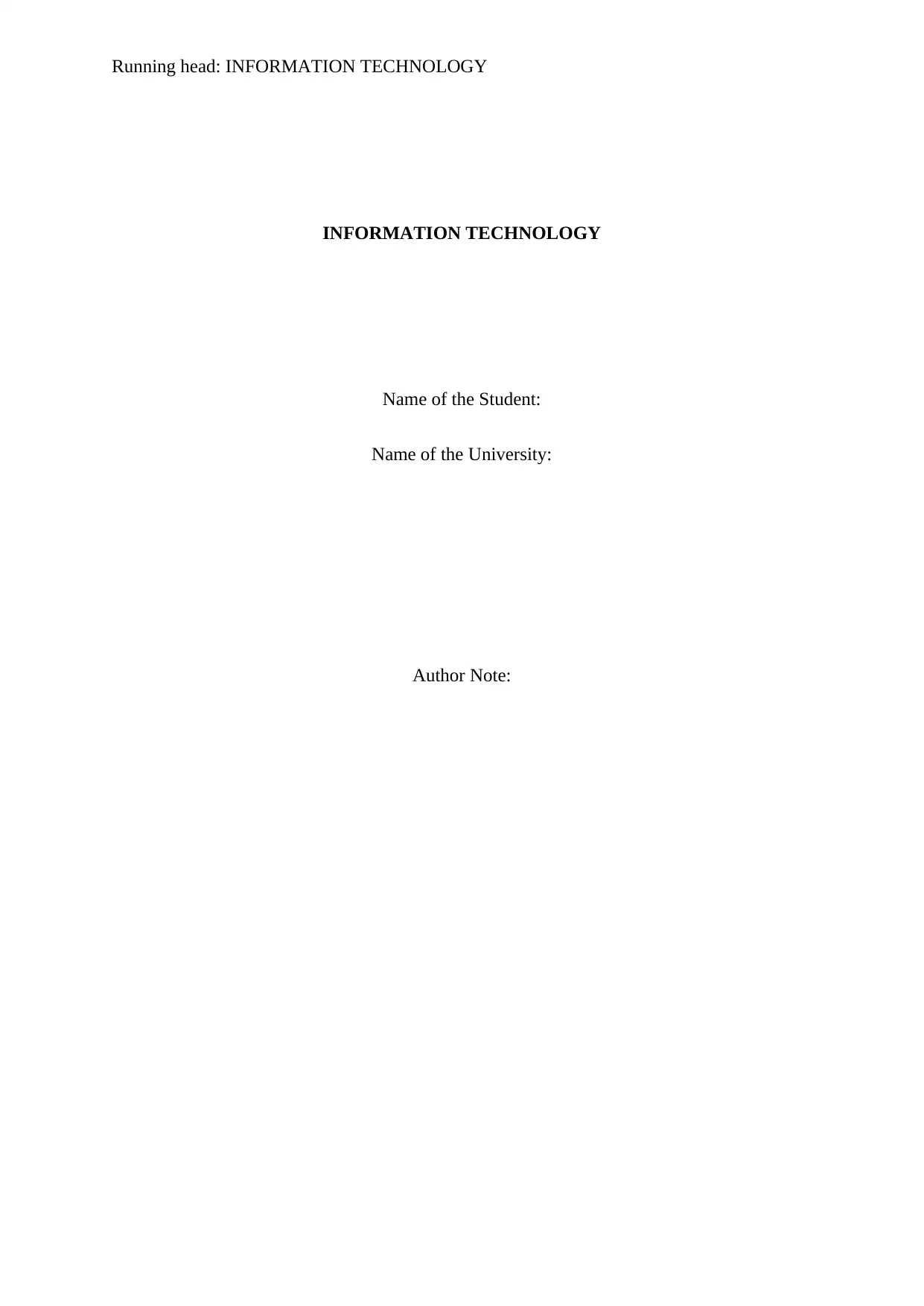
Running head: INFORMATION TECHNOLOGY
INFORMATION TECHNOLOGY
Name of the Student:
Name of the University:
Author Note:
INFORMATION TECHNOLOGY
Name of the Student:
Name of the University:
Author Note:
Paraphrase This Document
Need a fresh take? Get an instant paraphrase of this document with our AI Paraphraser
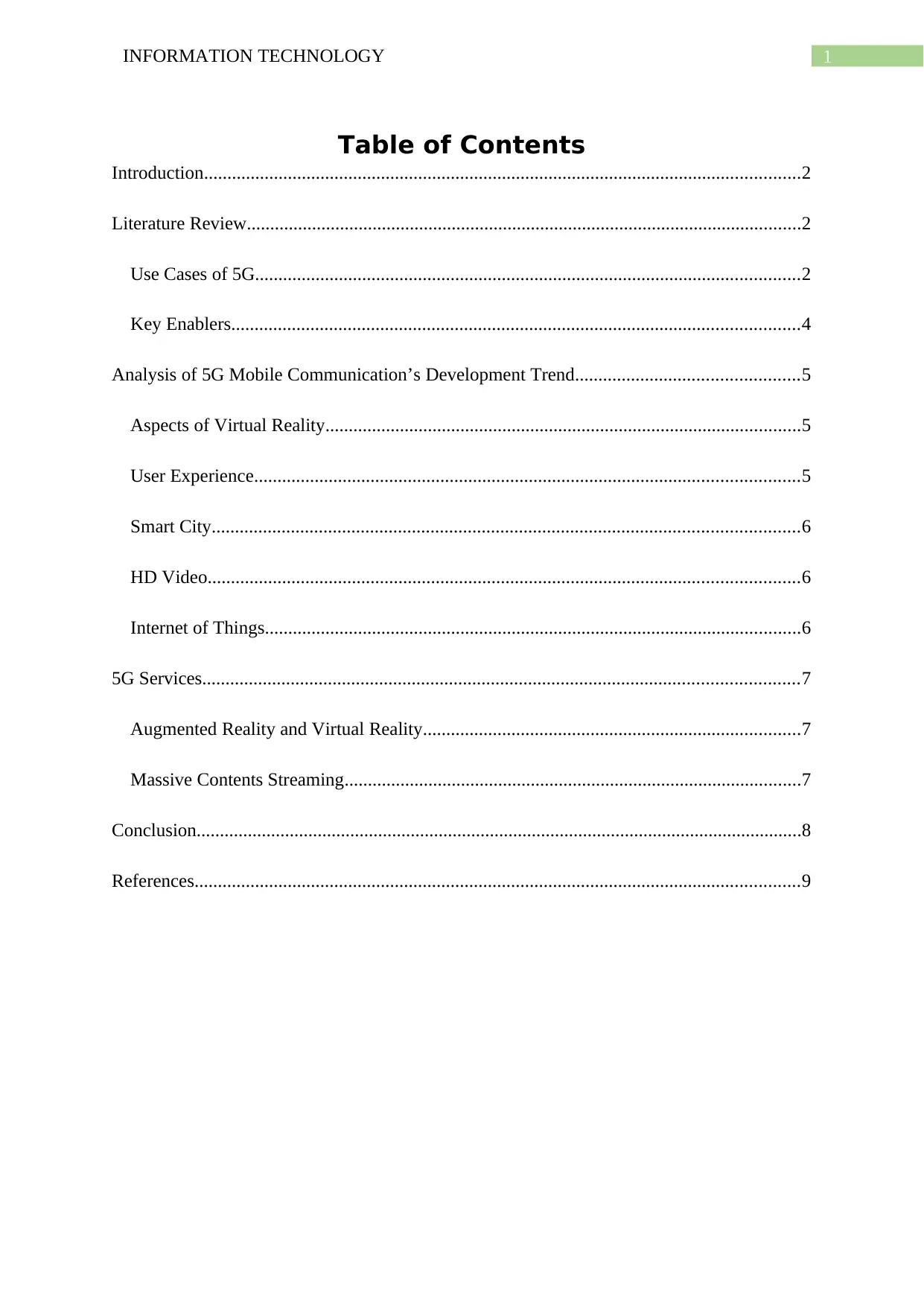
1INFORMATION TECHNOLOGY
Table of Contents
Introduction................................................................................................................................2
Literature Review.......................................................................................................................2
Use Cases of 5G.....................................................................................................................2
Key Enablers..........................................................................................................................4
Analysis of 5G Mobile Communication’s Development Trend................................................5
Aspects of Virtual Reality......................................................................................................5
User Experience.....................................................................................................................5
Smart City..............................................................................................................................6
HD Video...............................................................................................................................6
Internet of Things...................................................................................................................6
5G Services................................................................................................................................7
Augmented Reality and Virtual Reality.................................................................................7
Massive Contents Streaming..................................................................................................7
Conclusion..................................................................................................................................8
References..................................................................................................................................9
Table of Contents
Introduction................................................................................................................................2
Literature Review.......................................................................................................................2
Use Cases of 5G.....................................................................................................................2
Key Enablers..........................................................................................................................4
Analysis of 5G Mobile Communication’s Development Trend................................................5
Aspects of Virtual Reality......................................................................................................5
User Experience.....................................................................................................................5
Smart City..............................................................................................................................6
HD Video...............................................................................................................................6
Internet of Things...................................................................................................................6
5G Services................................................................................................................................7
Augmented Reality and Virtual Reality.................................................................................7
Massive Contents Streaming..................................................................................................7
Conclusion..................................................................................................................................8
References..................................................................................................................................9
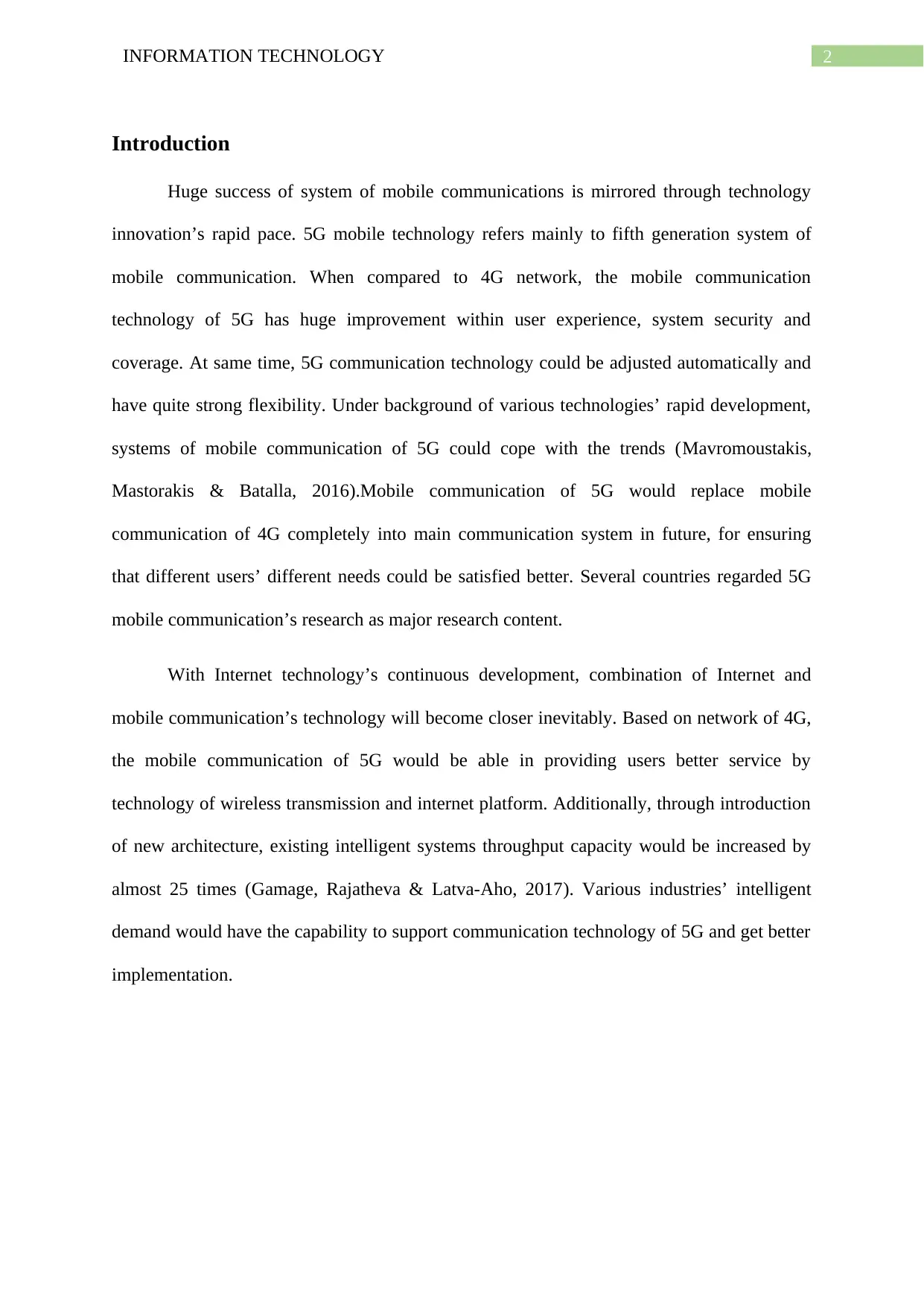
2INFORMATION TECHNOLOGY
Introduction
Huge success of system of mobile communications is mirrored through technology
innovation’s rapid pace. 5G mobile technology refers mainly to fifth generation system of
mobile communication. When compared to 4G network, the mobile communication
technology of 5G has huge improvement within user experience, system security and
coverage. At same time, 5G communication technology could be adjusted automatically and
have quite strong flexibility. Under background of various technologies’ rapid development,
systems of mobile communication of 5G could cope with the trends (Mavromoustakis,
Mastorakis & Batalla, 2016).Mobile communication of 5G would replace mobile
communication of 4G completely into main communication system in future, for ensuring
that different users’ different needs could be satisfied better. Several countries regarded 5G
mobile communication’s research as major research content.
With Internet technology’s continuous development, combination of Internet and
mobile communication’s technology will become closer inevitably. Based on network of 4G,
the mobile communication of 5G would be able in providing users better service by
technology of wireless transmission and internet platform. Additionally, through introduction
of new architecture, existing intelligent systems throughput capacity would be increased by
almost 25 times (Gamage, Rajatheva & Latva-Aho, 2017). Various industries’ intelligent
demand would have the capability to support communication technology of 5G and get better
implementation.
Introduction
Huge success of system of mobile communications is mirrored through technology
innovation’s rapid pace. 5G mobile technology refers mainly to fifth generation system of
mobile communication. When compared to 4G network, the mobile communication
technology of 5G has huge improvement within user experience, system security and
coverage. At same time, 5G communication technology could be adjusted automatically and
have quite strong flexibility. Under background of various technologies’ rapid development,
systems of mobile communication of 5G could cope with the trends (Mavromoustakis,
Mastorakis & Batalla, 2016).Mobile communication of 5G would replace mobile
communication of 4G completely into main communication system in future, for ensuring
that different users’ different needs could be satisfied better. Several countries regarded 5G
mobile communication’s research as major research content.
With Internet technology’s continuous development, combination of Internet and
mobile communication’s technology will become closer inevitably. Based on network of 4G,
the mobile communication of 5G would be able in providing users better service by
technology of wireless transmission and internet platform. Additionally, through introduction
of new architecture, existing intelligent systems throughput capacity would be increased by
almost 25 times (Gamage, Rajatheva & Latva-Aho, 2017). Various industries’ intelligent
demand would have the capability to support communication technology of 5G and get better
implementation.
⊘ This is a preview!⊘
Do you want full access?
Subscribe today to unlock all pages.

Trusted by 1+ million students worldwide
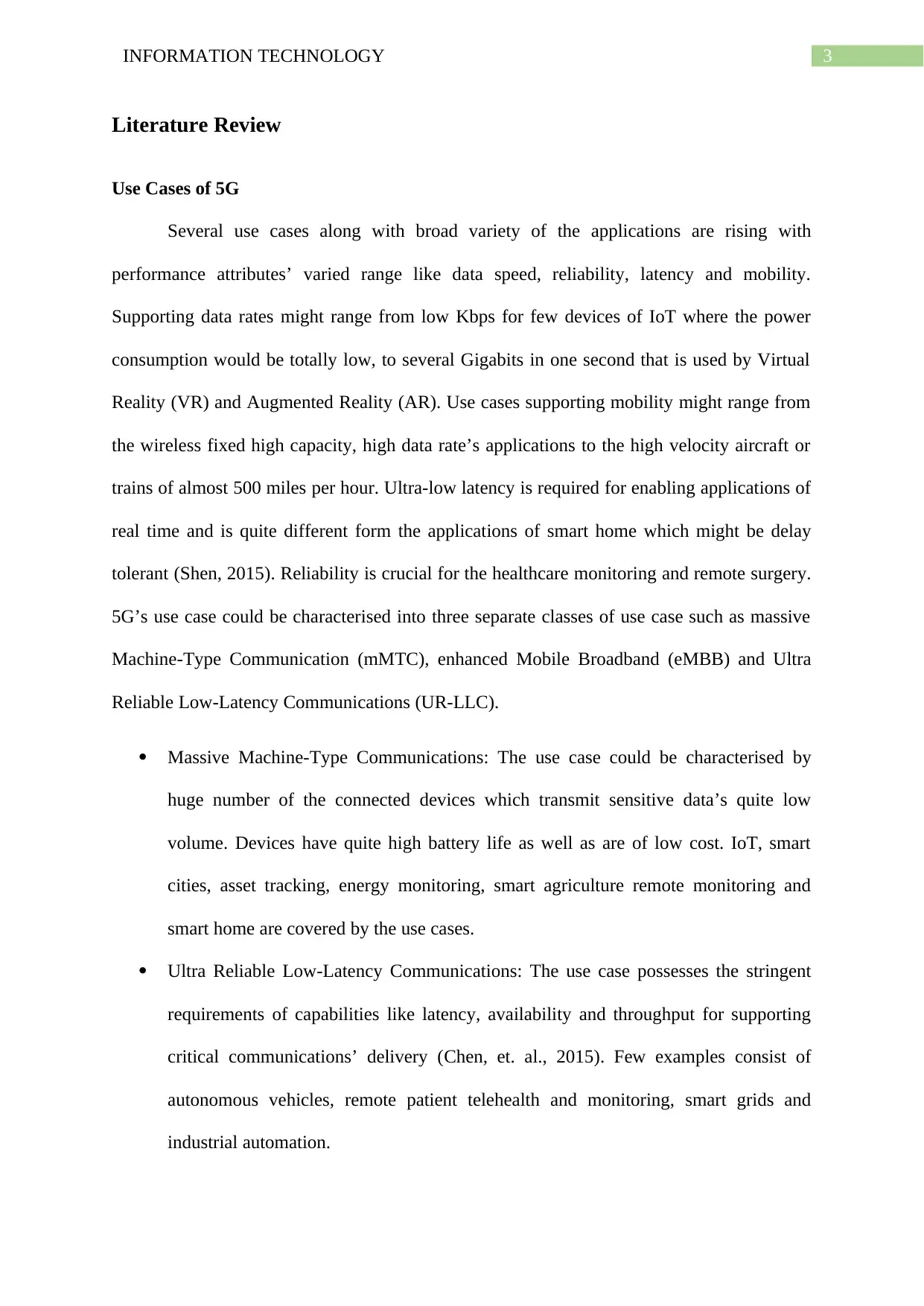
3INFORMATION TECHNOLOGY
Literature Review
Use Cases of 5G
Several use cases along with broad variety of the applications are rising with
performance attributes’ varied range like data speed, reliability, latency and mobility.
Supporting data rates might range from low Kbps for few devices of IoT where the power
consumption would be totally low, to several Gigabits in one second that is used by Virtual
Reality (VR) and Augmented Reality (AR). Use cases supporting mobility might range from
the wireless fixed high capacity, high data rate’s applications to the high velocity aircraft or
trains of almost 500 miles per hour. Ultra-low latency is required for enabling applications of
real time and is quite different form the applications of smart home which might be delay
tolerant (Shen, 2015). Reliability is crucial for the healthcare monitoring and remote surgery.
5G’s use case could be characterised into three separate classes of use case such as massive
Machine-Type Communication (mMTC), enhanced Mobile Broadband (eMBB) and Ultra
Reliable Low-Latency Communications (UR-LLC).
Massive Machine-Type Communications: The use case could be characterised by
huge number of the connected devices which transmit sensitive data’s quite low
volume. Devices have quite high battery life as well as are of low cost. IoT, smart
cities, asset tracking, energy monitoring, smart agriculture remote monitoring and
smart home are covered by the use cases.
Ultra Reliable Low-Latency Communications: The use case possesses the stringent
requirements of capabilities like latency, availability and throughput for supporting
critical communications’ delivery (Chen, et. al., 2015). Few examples consist of
autonomous vehicles, remote patient telehealth and monitoring, smart grids and
industrial automation.
Literature Review
Use Cases of 5G
Several use cases along with broad variety of the applications are rising with
performance attributes’ varied range like data speed, reliability, latency and mobility.
Supporting data rates might range from low Kbps for few devices of IoT where the power
consumption would be totally low, to several Gigabits in one second that is used by Virtual
Reality (VR) and Augmented Reality (AR). Use cases supporting mobility might range from
the wireless fixed high capacity, high data rate’s applications to the high velocity aircraft or
trains of almost 500 miles per hour. Ultra-low latency is required for enabling applications of
real time and is quite different form the applications of smart home which might be delay
tolerant (Shen, 2015). Reliability is crucial for the healthcare monitoring and remote surgery.
5G’s use case could be characterised into three separate classes of use case such as massive
Machine-Type Communication (mMTC), enhanced Mobile Broadband (eMBB) and Ultra
Reliable Low-Latency Communications (UR-LLC).
Massive Machine-Type Communications: The use case could be characterised by
huge number of the connected devices which transmit sensitive data’s quite low
volume. Devices have quite high battery life as well as are of low cost. IoT, smart
cities, asset tracking, energy monitoring, smart agriculture remote monitoring and
smart home are covered by the use cases.
Ultra Reliable Low-Latency Communications: The use case possesses the stringent
requirements of capabilities like latency, availability and throughput for supporting
critical communications’ delivery (Chen, et. al., 2015). Few examples consist of
autonomous vehicles, remote patient telehealth and monitoring, smart grids and
industrial automation.
Paraphrase This Document
Need a fresh take? Get an instant paraphrase of this document with our AI Paraphraser
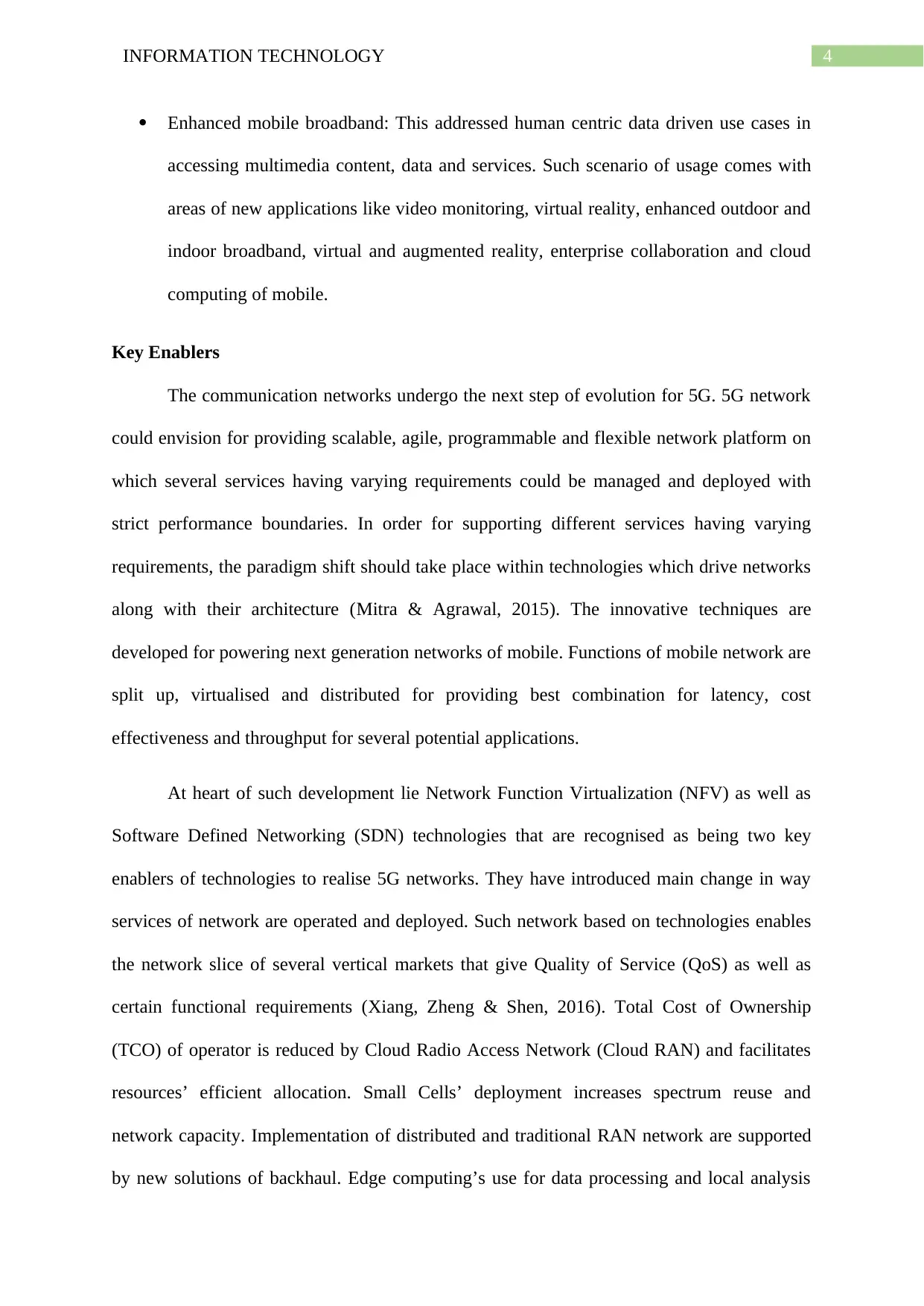
4INFORMATION TECHNOLOGY
Enhanced mobile broadband: This addressed human centric data driven use cases in
accessing multimedia content, data and services. Such scenario of usage comes with
areas of new applications like video monitoring, virtual reality, enhanced outdoor and
indoor broadband, virtual and augmented reality, enterprise collaboration and cloud
computing of mobile.
Key Enablers
The communication networks undergo the next step of evolution for 5G. 5G network
could envision for providing scalable, agile, programmable and flexible network platform on
which several services having varying requirements could be managed and deployed with
strict performance boundaries. In order for supporting different services having varying
requirements, the paradigm shift should take place within technologies which drive networks
along with their architecture (Mitra & Agrawal, 2015). The innovative techniques are
developed for powering next generation networks of mobile. Functions of mobile network are
split up, virtualised and distributed for providing best combination for latency, cost
effectiveness and throughput for several potential applications.
At heart of such development lie Network Function Virtualization (NFV) as well as
Software Defined Networking (SDN) technologies that are recognised as being two key
enablers of technologies to realise 5G networks. They have introduced main change in way
services of network are operated and deployed. Such network based on technologies enables
the network slice of several vertical markets that give Quality of Service (QoS) as well as
certain functional requirements (Xiang, Zheng & Shen, 2016). Total Cost of Ownership
(TCO) of operator is reduced by Cloud Radio Access Network (Cloud RAN) and facilitates
resources’ efficient allocation. Small Cells’ deployment increases spectrum reuse and
network capacity. Implementation of distributed and traditional RAN network are supported
by new solutions of backhaul. Edge computing’s use for data processing and local analysis
Enhanced mobile broadband: This addressed human centric data driven use cases in
accessing multimedia content, data and services. Such scenario of usage comes with
areas of new applications like video monitoring, virtual reality, enhanced outdoor and
indoor broadband, virtual and augmented reality, enterprise collaboration and cloud
computing of mobile.
Key Enablers
The communication networks undergo the next step of evolution for 5G. 5G network
could envision for providing scalable, agile, programmable and flexible network platform on
which several services having varying requirements could be managed and deployed with
strict performance boundaries. In order for supporting different services having varying
requirements, the paradigm shift should take place within technologies which drive networks
along with their architecture (Mitra & Agrawal, 2015). The innovative techniques are
developed for powering next generation networks of mobile. Functions of mobile network are
split up, virtualised and distributed for providing best combination for latency, cost
effectiveness and throughput for several potential applications.
At heart of such development lie Network Function Virtualization (NFV) as well as
Software Defined Networking (SDN) technologies that are recognised as being two key
enablers of technologies to realise 5G networks. They have introduced main change in way
services of network are operated and deployed. Such network based on technologies enables
the network slice of several vertical markets that give Quality of Service (QoS) as well as
certain functional requirements (Xiang, Zheng & Shen, 2016). Total Cost of Ownership
(TCO) of operator is reduced by Cloud Radio Access Network (Cloud RAN) and facilitates
resources’ efficient allocation. Small Cells’ deployment increases spectrum reuse and
network capacity. Implementation of distributed and traditional RAN network are supported
by new solutions of backhaul. Edge computing’s use for data processing and local analysis
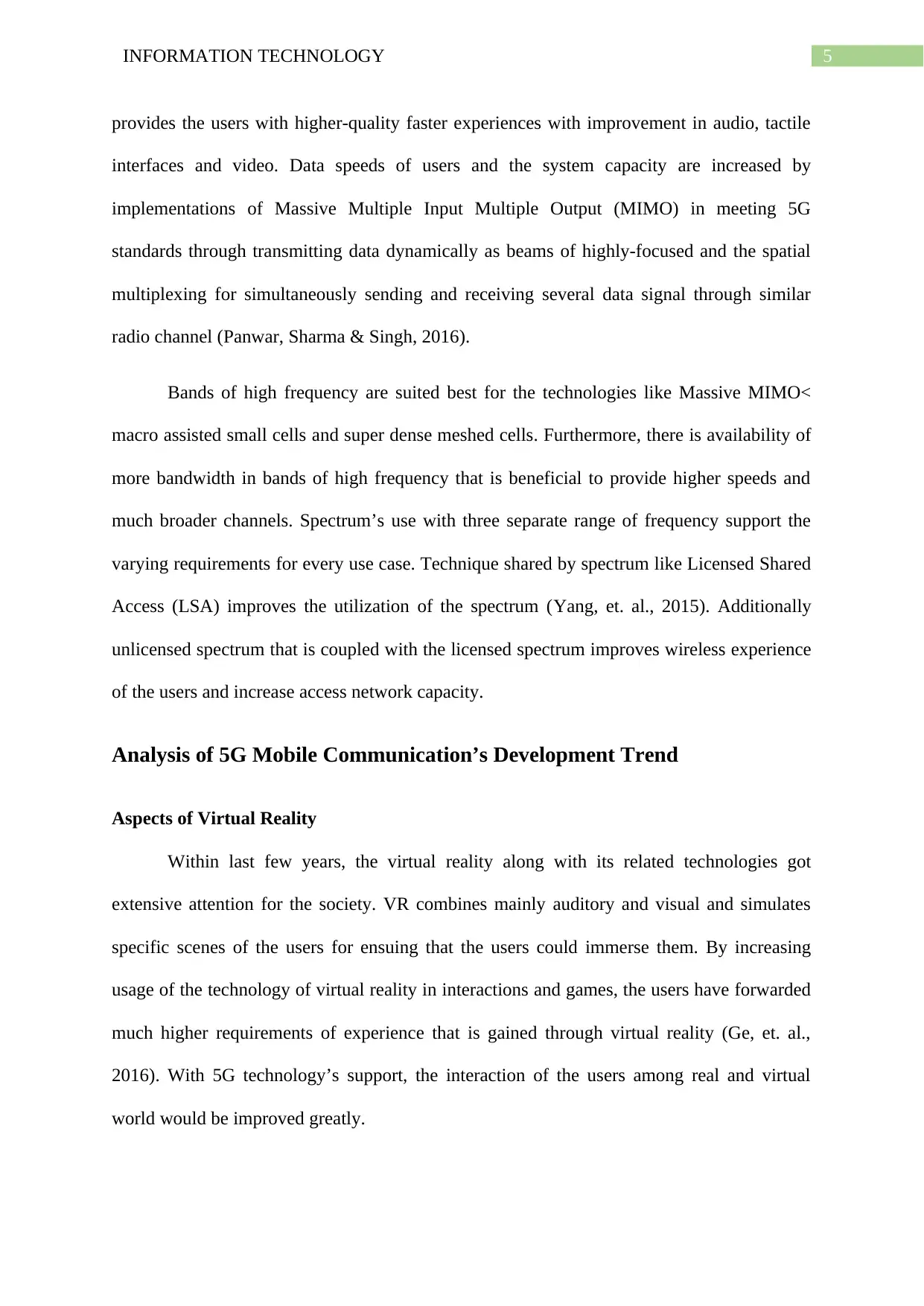
5INFORMATION TECHNOLOGY
provides the users with higher-quality faster experiences with improvement in audio, tactile
interfaces and video. Data speeds of users and the system capacity are increased by
implementations of Massive Multiple Input Multiple Output (MIMO) in meeting 5G
standards through transmitting data dynamically as beams of highly-focused and the spatial
multiplexing for simultaneously sending and receiving several data signal through similar
radio channel (Panwar, Sharma & Singh, 2016).
Bands of high frequency are suited best for the technologies like Massive MIMO<
macro assisted small cells and super dense meshed cells. Furthermore, there is availability of
more bandwidth in bands of high frequency that is beneficial to provide higher speeds and
much broader channels. Spectrum’s use with three separate range of frequency support the
varying requirements for every use case. Technique shared by spectrum like Licensed Shared
Access (LSA) improves the utilization of the spectrum (Yang, et. al., 2015). Additionally
unlicensed spectrum that is coupled with the licensed spectrum improves wireless experience
of the users and increase access network capacity.
Analysis of 5G Mobile Communication’s Development Trend
Aspects of Virtual Reality
Within last few years, the virtual reality along with its related technologies got
extensive attention for the society. VR combines mainly auditory and visual and simulates
specific scenes of the users for ensuing that the users could immerse them. By increasing
usage of the technology of virtual reality in interactions and games, the users have forwarded
much higher requirements of experience that is gained through virtual reality (Ge, et. al.,
2016). With 5G technology’s support, the interaction of the users among real and virtual
world would be improved greatly.
provides the users with higher-quality faster experiences with improvement in audio, tactile
interfaces and video. Data speeds of users and the system capacity are increased by
implementations of Massive Multiple Input Multiple Output (MIMO) in meeting 5G
standards through transmitting data dynamically as beams of highly-focused and the spatial
multiplexing for simultaneously sending and receiving several data signal through similar
radio channel (Panwar, Sharma & Singh, 2016).
Bands of high frequency are suited best for the technologies like Massive MIMO<
macro assisted small cells and super dense meshed cells. Furthermore, there is availability of
more bandwidth in bands of high frequency that is beneficial to provide higher speeds and
much broader channels. Spectrum’s use with three separate range of frequency support the
varying requirements for every use case. Technique shared by spectrum like Licensed Shared
Access (LSA) improves the utilization of the spectrum (Yang, et. al., 2015). Additionally
unlicensed spectrum that is coupled with the licensed spectrum improves wireless experience
of the users and increase access network capacity.
Analysis of 5G Mobile Communication’s Development Trend
Aspects of Virtual Reality
Within last few years, the virtual reality along with its related technologies got
extensive attention for the society. VR combines mainly auditory and visual and simulates
specific scenes of the users for ensuing that the users could immerse them. By increasing
usage of the technology of virtual reality in interactions and games, the users have forwarded
much higher requirements of experience that is gained through virtual reality (Ge, et. al.,
2016). With 5G technology’s support, the interaction of the users among real and virtual
world would be improved greatly.
⊘ This is a preview!⊘
Do you want full access?
Subscribe today to unlock all pages.

Trusted by 1+ million students worldwide
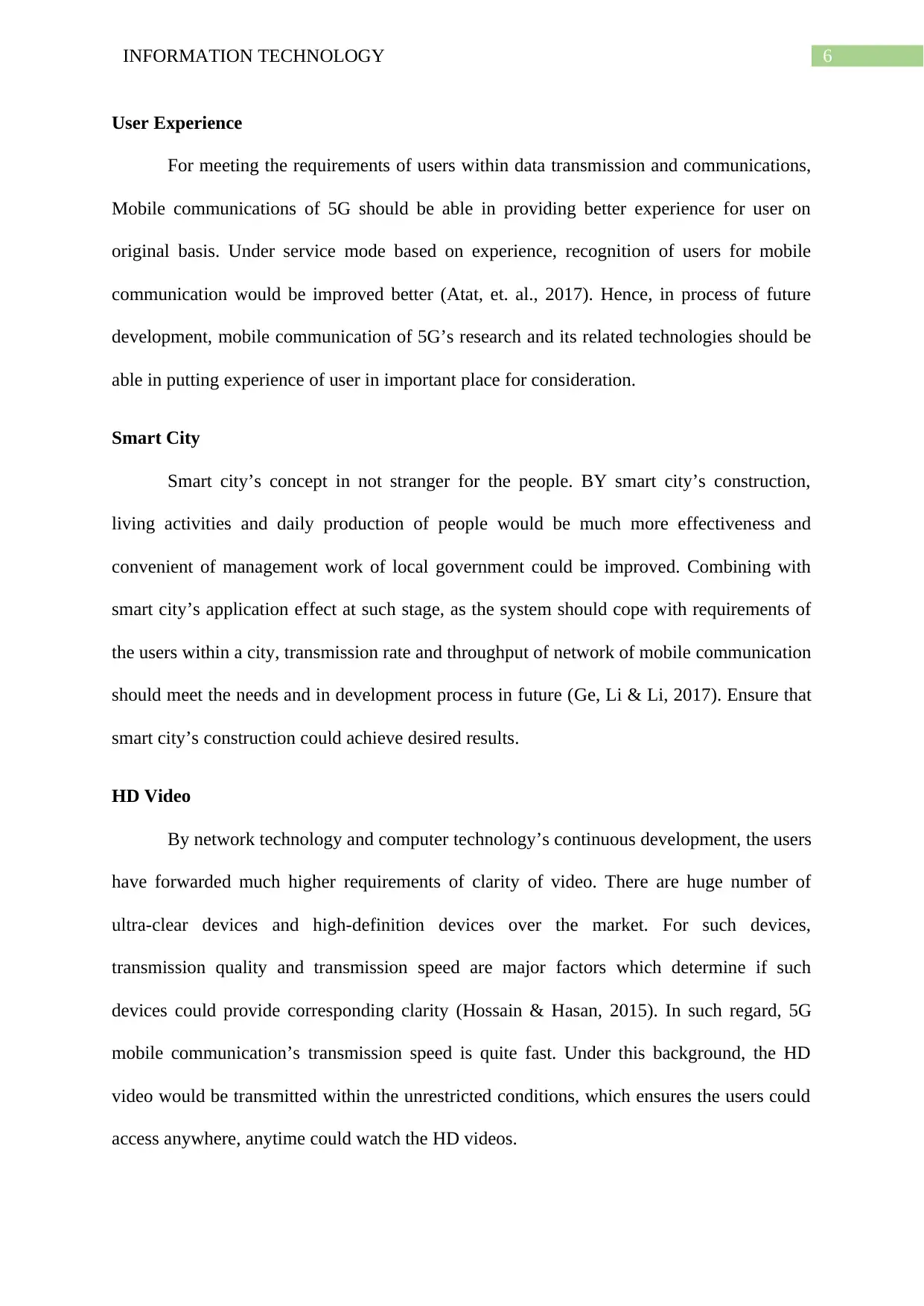
6INFORMATION TECHNOLOGY
User Experience
For meeting the requirements of users within data transmission and communications,
Mobile communications of 5G should be able in providing better experience for user on
original basis. Under service mode based on experience, recognition of users for mobile
communication would be improved better (Atat, et. al., 2017). Hence, in process of future
development, mobile communication of 5G’s research and its related technologies should be
able in putting experience of user in important place for consideration.
Smart City
Smart city’s concept in not stranger for the people. BY smart city’s construction,
living activities and daily production of people would be much more effectiveness and
convenient of management work of local government could be improved. Combining with
smart city’s application effect at such stage, as the system should cope with requirements of
the users within a city, transmission rate and throughput of network of mobile communication
should meet the needs and in development process in future (Ge, Li & Li, 2017). Ensure that
smart city’s construction could achieve desired results.
HD Video
By network technology and computer technology’s continuous development, the users
have forwarded much higher requirements of clarity of video. There are huge number of
ultra-clear devices and high-definition devices over the market. For such devices,
transmission quality and transmission speed are major factors which determine if such
devices could provide corresponding clarity (Hossain & Hasan, 2015). In such regard, 5G
mobile communication’s transmission speed is quite fast. Under this background, the HD
video would be transmitted within the unrestricted conditions, which ensures the users could
access anywhere, anytime could watch the HD videos.
User Experience
For meeting the requirements of users within data transmission and communications,
Mobile communications of 5G should be able in providing better experience for user on
original basis. Under service mode based on experience, recognition of users for mobile
communication would be improved better (Atat, et. al., 2017). Hence, in process of future
development, mobile communication of 5G’s research and its related technologies should be
able in putting experience of user in important place for consideration.
Smart City
Smart city’s concept in not stranger for the people. BY smart city’s construction,
living activities and daily production of people would be much more effectiveness and
convenient of management work of local government could be improved. Combining with
smart city’s application effect at such stage, as the system should cope with requirements of
the users within a city, transmission rate and throughput of network of mobile communication
should meet the needs and in development process in future (Ge, Li & Li, 2017). Ensure that
smart city’s construction could achieve desired results.
HD Video
By network technology and computer technology’s continuous development, the users
have forwarded much higher requirements of clarity of video. There are huge number of
ultra-clear devices and high-definition devices over the market. For such devices,
transmission quality and transmission speed are major factors which determine if such
devices could provide corresponding clarity (Hossain & Hasan, 2015). In such regard, 5G
mobile communication’s transmission speed is quite fast. Under this background, the HD
video would be transmitted within the unrestricted conditions, which ensures the users could
access anywhere, anytime could watch the HD videos.
Paraphrase This Document
Need a fresh take? Get an instant paraphrase of this document with our AI Paraphraser
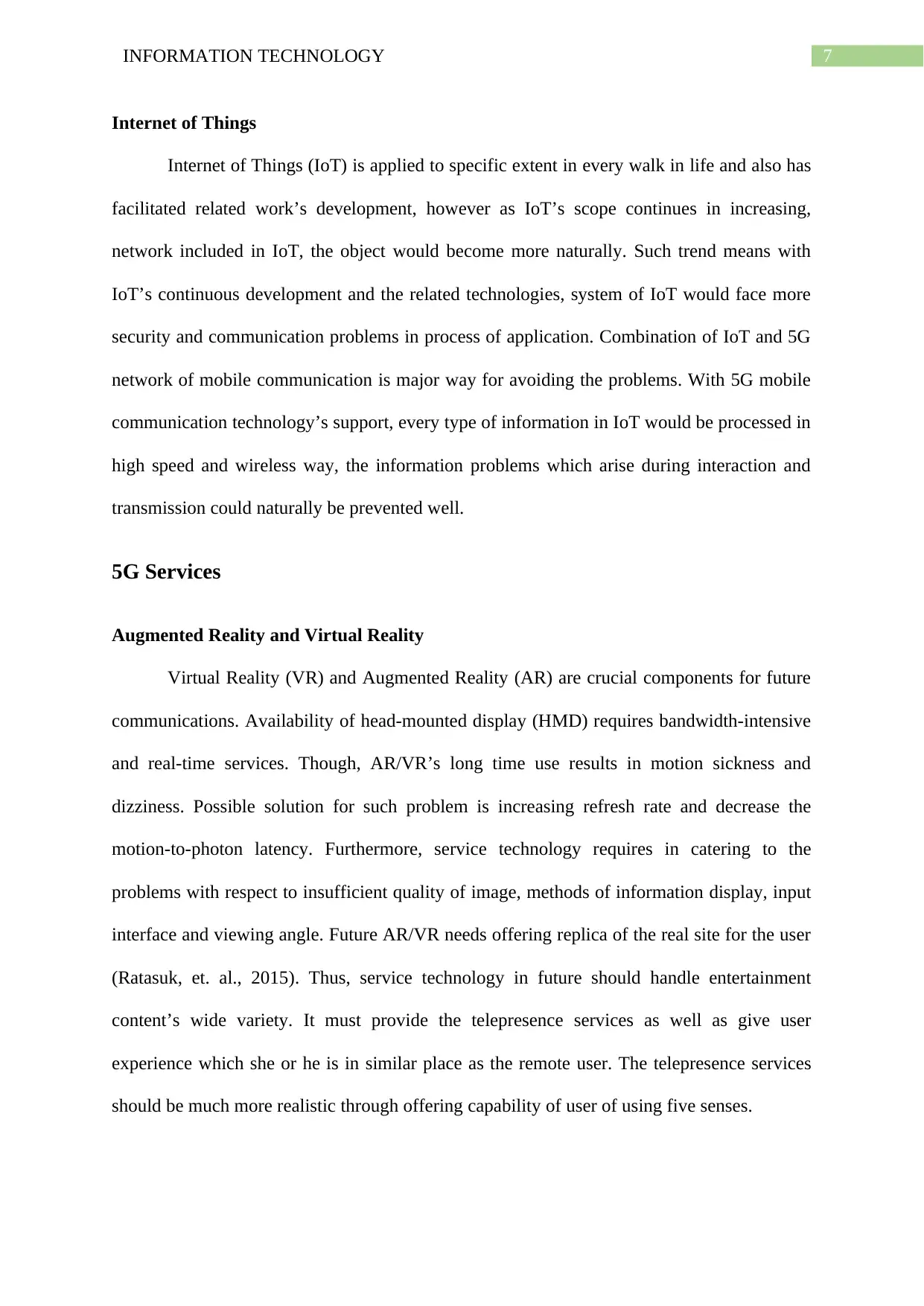
7INFORMATION TECHNOLOGY
Internet of Things
Internet of Things (IoT) is applied to specific extent in every walk in life and also has
facilitated related work’s development, however as IoT’s scope continues in increasing,
network included in IoT, the object would become more naturally. Such trend means with
IoT’s continuous development and the related technologies, system of IoT would face more
security and communication problems in process of application. Combination of IoT and 5G
network of mobile communication is major way for avoiding the problems. With 5G mobile
communication technology’s support, every type of information in IoT would be processed in
high speed and wireless way, the information problems which arise during interaction and
transmission could naturally be prevented well.
5G Services
Augmented Reality and Virtual Reality
Virtual Reality (VR) and Augmented Reality (AR) are crucial components for future
communications. Availability of head-mounted display (HMD) requires bandwidth-intensive
and real-time services. Though, AR/VR’s long time use results in motion sickness and
dizziness. Possible solution for such problem is increasing refresh rate and decrease the
motion-to-photon latency. Furthermore, service technology requires in catering to the
problems with respect to insufficient quality of image, methods of information display, input
interface and viewing angle. Future AR/VR needs offering replica of the real site for the user
(Ratasuk, et. al., 2015). Thus, service technology in future should handle entertainment
content’s wide variety. It must provide the telepresence services as well as give user
experience which she or he is in similar place as the remote user. The telepresence services
should be much more realistic through offering capability of user of using five senses.
Internet of Things
Internet of Things (IoT) is applied to specific extent in every walk in life and also has
facilitated related work’s development, however as IoT’s scope continues in increasing,
network included in IoT, the object would become more naturally. Such trend means with
IoT’s continuous development and the related technologies, system of IoT would face more
security and communication problems in process of application. Combination of IoT and 5G
network of mobile communication is major way for avoiding the problems. With 5G mobile
communication technology’s support, every type of information in IoT would be processed in
high speed and wireless way, the information problems which arise during interaction and
transmission could naturally be prevented well.
5G Services
Augmented Reality and Virtual Reality
Virtual Reality (VR) and Augmented Reality (AR) are crucial components for future
communications. Availability of head-mounted display (HMD) requires bandwidth-intensive
and real-time services. Though, AR/VR’s long time use results in motion sickness and
dizziness. Possible solution for such problem is increasing refresh rate and decrease the
motion-to-photon latency. Furthermore, service technology requires in catering to the
problems with respect to insufficient quality of image, methods of information display, input
interface and viewing angle. Future AR/VR needs offering replica of the real site for the user
(Ratasuk, et. al., 2015). Thus, service technology in future should handle entertainment
content’s wide variety. It must provide the telepresence services as well as give user
experience which she or he is in similar place as the remote user. The telepresence services
should be much more realistic through offering capability of user of using five senses.
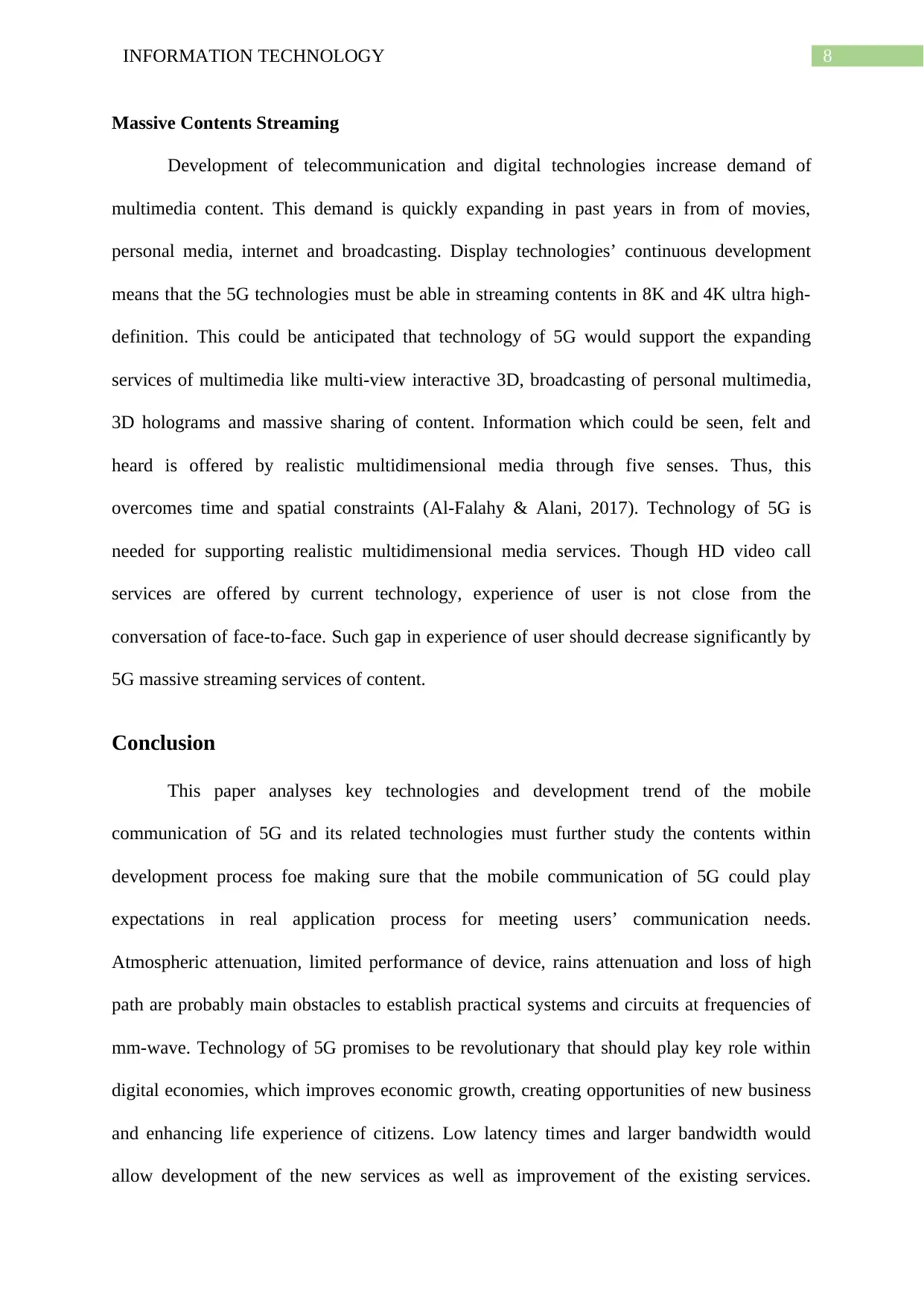
8INFORMATION TECHNOLOGY
Massive Contents Streaming
Development of telecommunication and digital technologies increase demand of
multimedia content. This demand is quickly expanding in past years in from of movies,
personal media, internet and broadcasting. Display technologies’ continuous development
means that the 5G technologies must be able in streaming contents in 8K and 4K ultra high-
definition. This could be anticipated that technology of 5G would support the expanding
services of multimedia like multi-view interactive 3D, broadcasting of personal multimedia,
3D holograms and massive sharing of content. Information which could be seen, felt and
heard is offered by realistic multidimensional media through five senses. Thus, this
overcomes time and spatial constraints (Al-Falahy & Alani, 2017). Technology of 5G is
needed for supporting realistic multidimensional media services. Though HD video call
services are offered by current technology, experience of user is not close from the
conversation of face-to-face. Such gap in experience of user should decrease significantly by
5G massive streaming services of content.
Conclusion
This paper analyses key technologies and development trend of the mobile
communication of 5G and its related technologies must further study the contents within
development process foe making sure that the mobile communication of 5G could play
expectations in real application process for meeting users’ communication needs.
Atmospheric attenuation, limited performance of device, rains attenuation and loss of high
path are probably main obstacles to establish practical systems and circuits at frequencies of
mm-wave. Technology of 5G promises to be revolutionary that should play key role within
digital economies, which improves economic growth, creating opportunities of new business
and enhancing life experience of citizens. Low latency times and larger bandwidth would
allow development of the new services as well as improvement of the existing services.
Massive Contents Streaming
Development of telecommunication and digital technologies increase demand of
multimedia content. This demand is quickly expanding in past years in from of movies,
personal media, internet and broadcasting. Display technologies’ continuous development
means that the 5G technologies must be able in streaming contents in 8K and 4K ultra high-
definition. This could be anticipated that technology of 5G would support the expanding
services of multimedia like multi-view interactive 3D, broadcasting of personal multimedia,
3D holograms and massive sharing of content. Information which could be seen, felt and
heard is offered by realistic multidimensional media through five senses. Thus, this
overcomes time and spatial constraints (Al-Falahy & Alani, 2017). Technology of 5G is
needed for supporting realistic multidimensional media services. Though HD video call
services are offered by current technology, experience of user is not close from the
conversation of face-to-face. Such gap in experience of user should decrease significantly by
5G massive streaming services of content.
Conclusion
This paper analyses key technologies and development trend of the mobile
communication of 5G and its related technologies must further study the contents within
development process foe making sure that the mobile communication of 5G could play
expectations in real application process for meeting users’ communication needs.
Atmospheric attenuation, limited performance of device, rains attenuation and loss of high
path are probably main obstacles to establish practical systems and circuits at frequencies of
mm-wave. Technology of 5G promises to be revolutionary that should play key role within
digital economies, which improves economic growth, creating opportunities of new business
and enhancing life experience of citizens. Low latency times and larger bandwidth would
allow development of the new services as well as improvement of the existing services.
⊘ This is a preview!⊘
Do you want full access?
Subscribe today to unlock all pages.

Trusted by 1+ million students worldwide
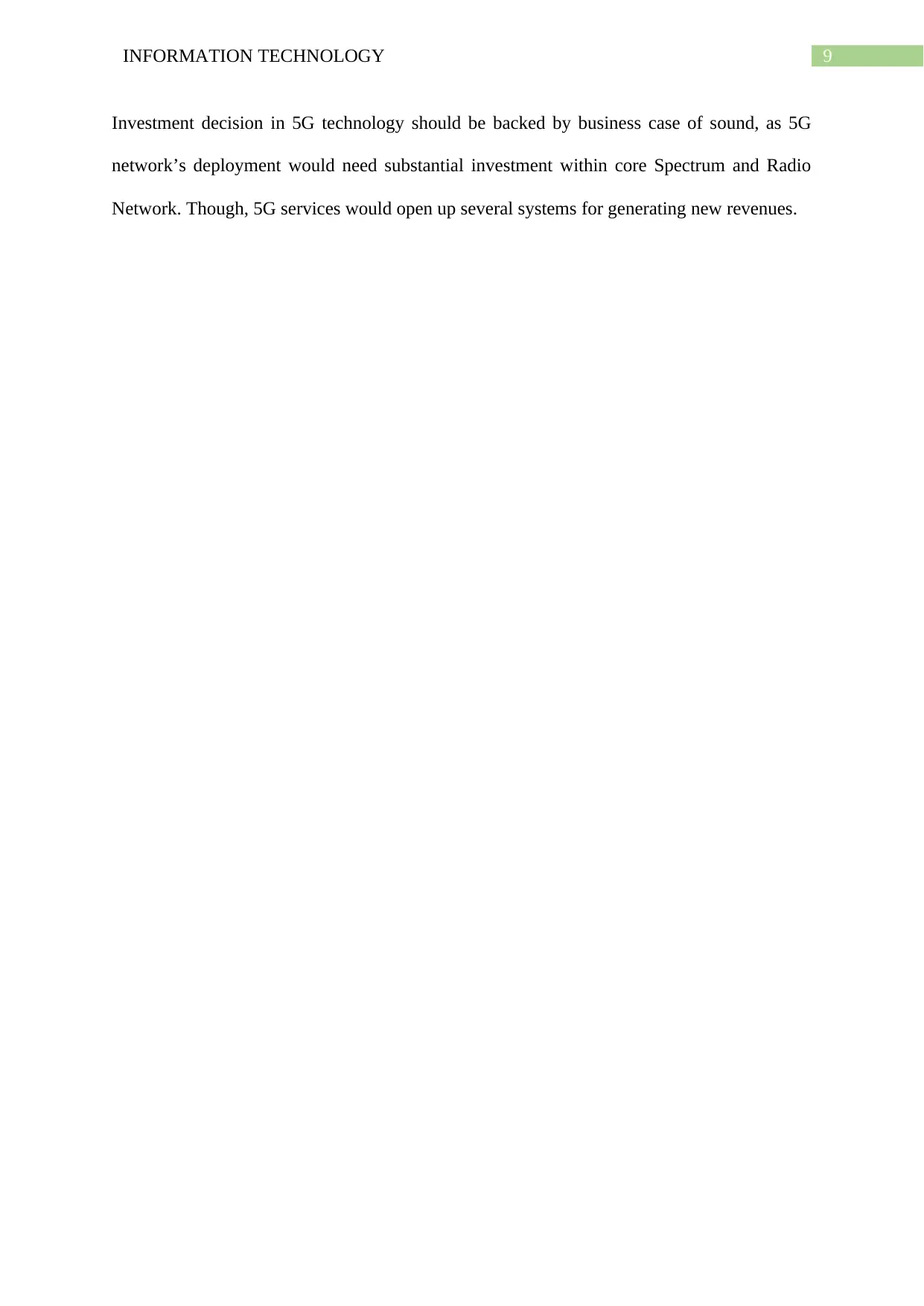
9INFORMATION TECHNOLOGY
Investment decision in 5G technology should be backed by business case of sound, as 5G
network’s deployment would need substantial investment within core Spectrum and Radio
Network. Though, 5G services would open up several systems for generating new revenues.
Investment decision in 5G technology should be backed by business case of sound, as 5G
network’s deployment would need substantial investment within core Spectrum and Radio
Network. Though, 5G services would open up several systems for generating new revenues.
Paraphrase This Document
Need a fresh take? Get an instant paraphrase of this document with our AI Paraphraser
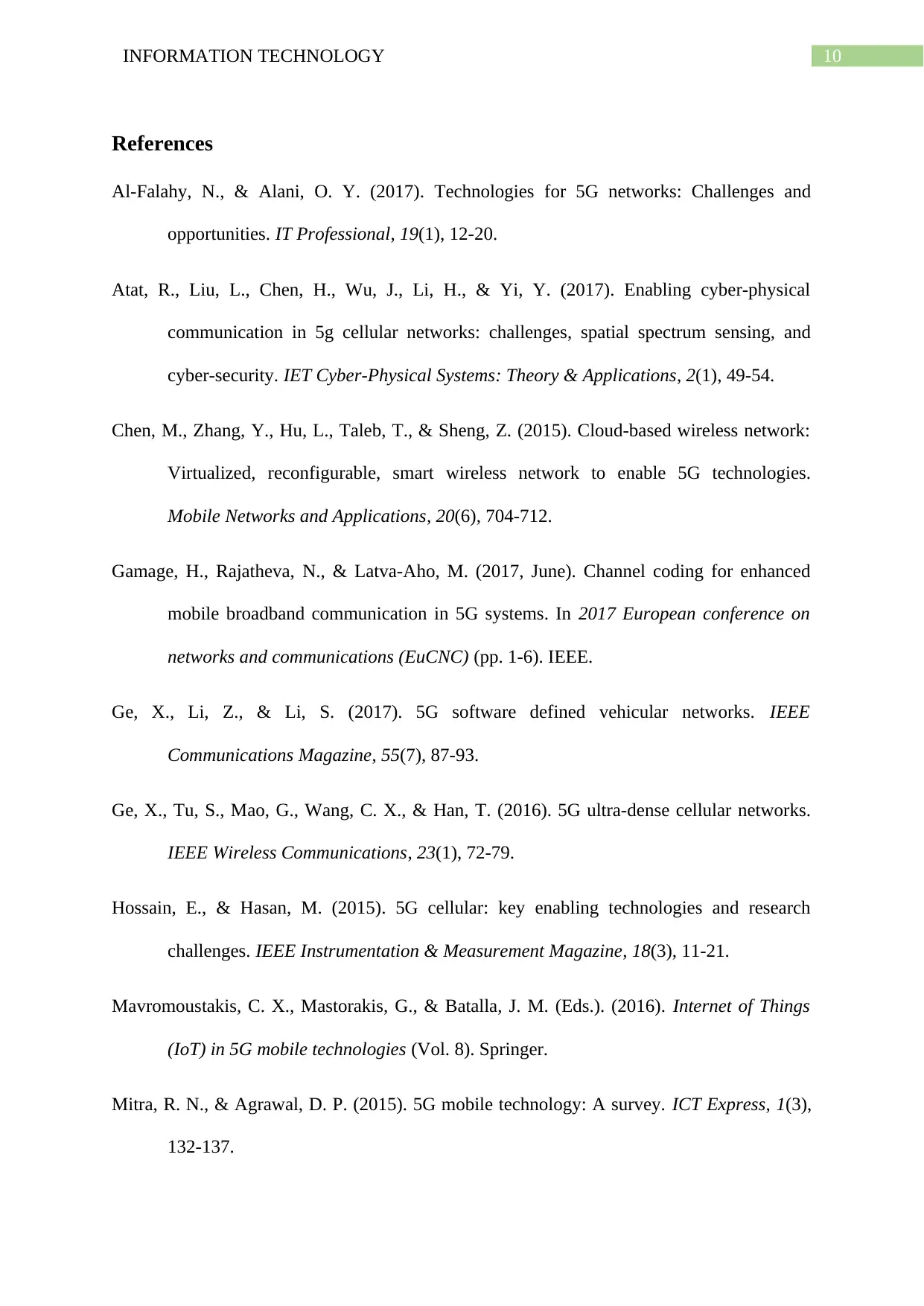
10INFORMATION TECHNOLOGY
References
Al-Falahy, N., & Alani, O. Y. (2017). Technologies for 5G networks: Challenges and
opportunities. IT Professional, 19(1), 12-20.
Atat, R., Liu, L., Chen, H., Wu, J., Li, H., & Yi, Y. (2017). Enabling cyber-physical
communication in 5g cellular networks: challenges, spatial spectrum sensing, and
cyber-security. IET Cyber-Physical Systems: Theory & Applications, 2(1), 49-54.
Chen, M., Zhang, Y., Hu, L., Taleb, T., & Sheng, Z. (2015). Cloud-based wireless network:
Virtualized, reconfigurable, smart wireless network to enable 5G technologies.
Mobile Networks and Applications, 20(6), 704-712.
Gamage, H., Rajatheva, N., & Latva-Aho, M. (2017, June). Channel coding for enhanced
mobile broadband communication in 5G systems. In 2017 European conference on
networks and communications (EuCNC) (pp. 1-6). IEEE.
Ge, X., Li, Z., & Li, S. (2017). 5G software defined vehicular networks. IEEE
Communications Magazine, 55(7), 87-93.
Ge, X., Tu, S., Mao, G., Wang, C. X., & Han, T. (2016). 5G ultra-dense cellular networks.
IEEE Wireless Communications, 23(1), 72-79.
Hossain, E., & Hasan, M. (2015). 5G cellular: key enabling technologies and research
challenges. IEEE Instrumentation & Measurement Magazine, 18(3), 11-21.
Mavromoustakis, C. X., Mastorakis, G., & Batalla, J. M. (Eds.). (2016). Internet of Things
(IoT) in 5G mobile technologies (Vol. 8). Springer.
Mitra, R. N., & Agrawal, D. P. (2015). 5G mobile technology: A survey. ICT Express, 1(3),
132-137.
References
Al-Falahy, N., & Alani, O. Y. (2017). Technologies for 5G networks: Challenges and
opportunities. IT Professional, 19(1), 12-20.
Atat, R., Liu, L., Chen, H., Wu, J., Li, H., & Yi, Y. (2017). Enabling cyber-physical
communication in 5g cellular networks: challenges, spatial spectrum sensing, and
cyber-security. IET Cyber-Physical Systems: Theory & Applications, 2(1), 49-54.
Chen, M., Zhang, Y., Hu, L., Taleb, T., & Sheng, Z. (2015). Cloud-based wireless network:
Virtualized, reconfigurable, smart wireless network to enable 5G technologies.
Mobile Networks and Applications, 20(6), 704-712.
Gamage, H., Rajatheva, N., & Latva-Aho, M. (2017, June). Channel coding for enhanced
mobile broadband communication in 5G systems. In 2017 European conference on
networks and communications (EuCNC) (pp. 1-6). IEEE.
Ge, X., Li, Z., & Li, S. (2017). 5G software defined vehicular networks. IEEE
Communications Magazine, 55(7), 87-93.
Ge, X., Tu, S., Mao, G., Wang, C. X., & Han, T. (2016). 5G ultra-dense cellular networks.
IEEE Wireless Communications, 23(1), 72-79.
Hossain, E., & Hasan, M. (2015). 5G cellular: key enabling technologies and research
challenges. IEEE Instrumentation & Measurement Magazine, 18(3), 11-21.
Mavromoustakis, C. X., Mastorakis, G., & Batalla, J. M. (Eds.). (2016). Internet of Things
(IoT) in 5G mobile technologies (Vol. 8). Springer.
Mitra, R. N., & Agrawal, D. P. (2015). 5G mobile technology: A survey. ICT Express, 1(3),
132-137.
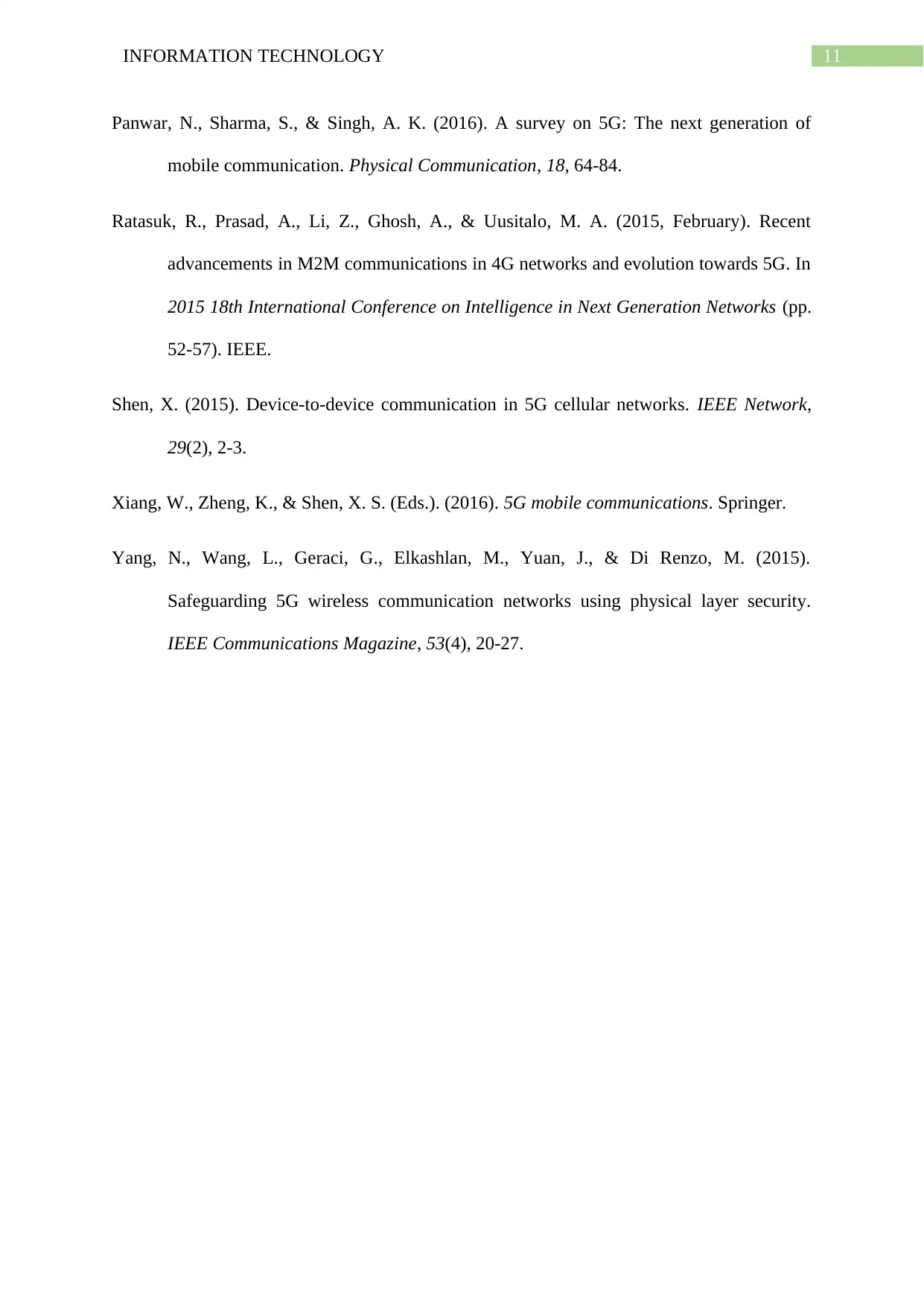
11INFORMATION TECHNOLOGY
Panwar, N., Sharma, S., & Singh, A. K. (2016). A survey on 5G: The next generation of
mobile communication. Physical Communication, 18, 64-84.
Ratasuk, R., Prasad, A., Li, Z., Ghosh, A., & Uusitalo, M. A. (2015, February). Recent
advancements in M2M communications in 4G networks and evolution towards 5G. In
2015 18th International Conference on Intelligence in Next Generation Networks (pp.
52-57). IEEE.
Shen, X. (2015). Device-to-device communication in 5G cellular networks. IEEE Network,
29(2), 2-3.
Xiang, W., Zheng, K., & Shen, X. S. (Eds.). (2016). 5G mobile communications. Springer.
Yang, N., Wang, L., Geraci, G., Elkashlan, M., Yuan, J., & Di Renzo, M. (2015).
Safeguarding 5G wireless communication networks using physical layer security.
IEEE Communications Magazine, 53(4), 20-27.
Panwar, N., Sharma, S., & Singh, A. K. (2016). A survey on 5G: The next generation of
mobile communication. Physical Communication, 18, 64-84.
Ratasuk, R., Prasad, A., Li, Z., Ghosh, A., & Uusitalo, M. A. (2015, February). Recent
advancements in M2M communications in 4G networks and evolution towards 5G. In
2015 18th International Conference on Intelligence in Next Generation Networks (pp.
52-57). IEEE.
Shen, X. (2015). Device-to-device communication in 5G cellular networks. IEEE Network,
29(2), 2-3.
Xiang, W., Zheng, K., & Shen, X. S. (Eds.). (2016). 5G mobile communications. Springer.
Yang, N., Wang, L., Geraci, G., Elkashlan, M., Yuan, J., & Di Renzo, M. (2015).
Safeguarding 5G wireless communication networks using physical layer security.
IEEE Communications Magazine, 53(4), 20-27.
⊘ This is a preview!⊘
Do you want full access?
Subscribe today to unlock all pages.

Trusted by 1+ million students worldwide
1 out of 12
Related Documents
Your All-in-One AI-Powered Toolkit for Academic Success.
+13062052269
info@desklib.com
Available 24*7 on WhatsApp / Email
![[object Object]](/_next/static/media/star-bottom.7253800d.svg)
Unlock your academic potential
Copyright © 2020–2025 A2Z Services. All Rights Reserved. Developed and managed by ZUCOL.





